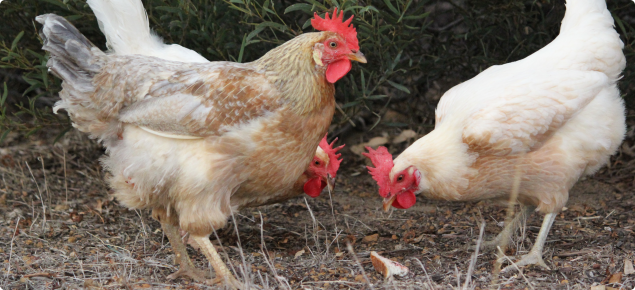| Report signs of avian influenza in birds |
|---|
| Any signs of avian influenza in birds must be reported to:
The earlier the disease is detected, the less it will spread and the faster it can be eradicated. |
Avian influenza overview
Avian influenza is a common viral infection of wild waterbirds throughout the world, including Australia. The virus is almost always harmless to these waterbirds, but can mutate to become highly pathogenic if it comes into contact with non-waterbird species, particularly poultry. Depending on the strain, the virus causes a wide range of signs in poultry from high mortality to no obvious signs.
Avian influenza strains are classified as either highly pathogenic or low pathogenic.
Highly pathogenic avian influenza (HPAI) causes sudden, severe disease and very high death rates in birds. The H5N1 strain present in Asia, Africa and Europe, which can also infect humans, is an example of a highly pathogenic strain. The H5N1 strain has not been found in Australia.
Low pathogenic avian influenza (LPAI) may cause some deaths in birds and reduce production. It may cause mild signs such as slight facial swelling or nasal discharge, coughing or sneezing, or birds may not show any signs of infection.
Do we have avian influenza in Australia?
There have been a number of outbreaks of highly pathogenic avian influenza in Australian poultry in recent years, all in eastern Australia. All outbreaks were eradicated and no people were affected. None of these outbreaks involved the H5N1 strain. The source of the outbreaks is thought to be water or feed contaminated by wild birds infected with low pathogenic avian influenza, which subsequently mutated to a highly pathogenic strain.
DPIRD carries out surveillance of waterbirds annually for avian influenza, which shows that low pathogenic avian influenza circulates in wild waterbirds without the birds showing signs of disease.
Low pathogenic avian influenza has occasionally occurred within farmed birds in Australia and has been quickly controlled under national protocols (AUSVETPLAN).
What are the signs of avian influenza?
Signs can vary with the species affected, bird age, the virus strain and the bird’s environment.
Signs of severe highly pathogenic avian influenza:
- sudden death of large numbers of birds without warning signs.
Signs of less severe highly pathogenic avian influenza:
- depression
- reduced food intake
- weakness
- soft-shelled eggs
- stopping laying
- dark, thickened combs and wattles
- bleeding
- diarrhoea
- coughing
- difficulty breathing.
Signs of low pathogenic avian influenza:
- depression
- reduced food intake
- reduced laying
- nasal discharge, coughing, sneezing
- diarrhoea.
Why should I report avian influenza signs?
Avian influenza is a reportable disease. If you see signs of avian influenza in birds, you are legally required to report it to DPIRD.
The earlier the disease is detected, the faster it can be eradicated. If you delay reporting the disease, it will spread to other birds.
How do I report avian influenza signs?
If you see any of the signs of avian influenza in your birds or wild birds, call:
- your private vet, or
- your local DPIRD veterinary officer, or
- the Emergency Animal Disease hotline on 1800 675 888.
Contacts for DPIRD vets are available on the webpage Livestock Biosecurity contacts.
How does avian influenza spread?
Wild waterbirds are the natural reservoir of avian influenza viruses. Infected birds spread the virus through their faeces and nasal and eye discharges.
Domestic birds can catch avian influenza by:
- direct contact with an infected bird
- contamination of water or food by infected birds
- contact with people, equipment, vehicles, shoes or clothing contaminated by infected birds.
What is the treatment for avian influenza?
There is no treatment for avian influenza in birds.
How can I reduce the risk of avian influenza occurring in my birds?
The following simple biosecurity measures can help prevent disease outbreaks:
- do not allow your birds to have any contact with wild birds
- ensure your birds’ water supply is not contaminated by wild birds or other animal waste. Water from rain, dams or rivers must be chlorinated before use
- ensure food is not contaminated by wild birds or other animal waste
- control rodents
- quarantine new birds
- limit visitors to your birds. Ensure visitors have clean hands, clothing and footwear, and cover their hair
- restrict employees from having contact with any birds outside of work
- keep equipment and poultry yards clean
- locate poultry sheds and aviaries away from wild waterbirds
- wash hands before and after handling birds.
See the comprehensive bird biosecurity guidelines on the federal Department of Agriculture and Water Resources website for more information.
DPIRD veterinary contacts
See the Livestock Biosecurity contacts webpage for contact details of your nearest DPIRD Field Vet.

